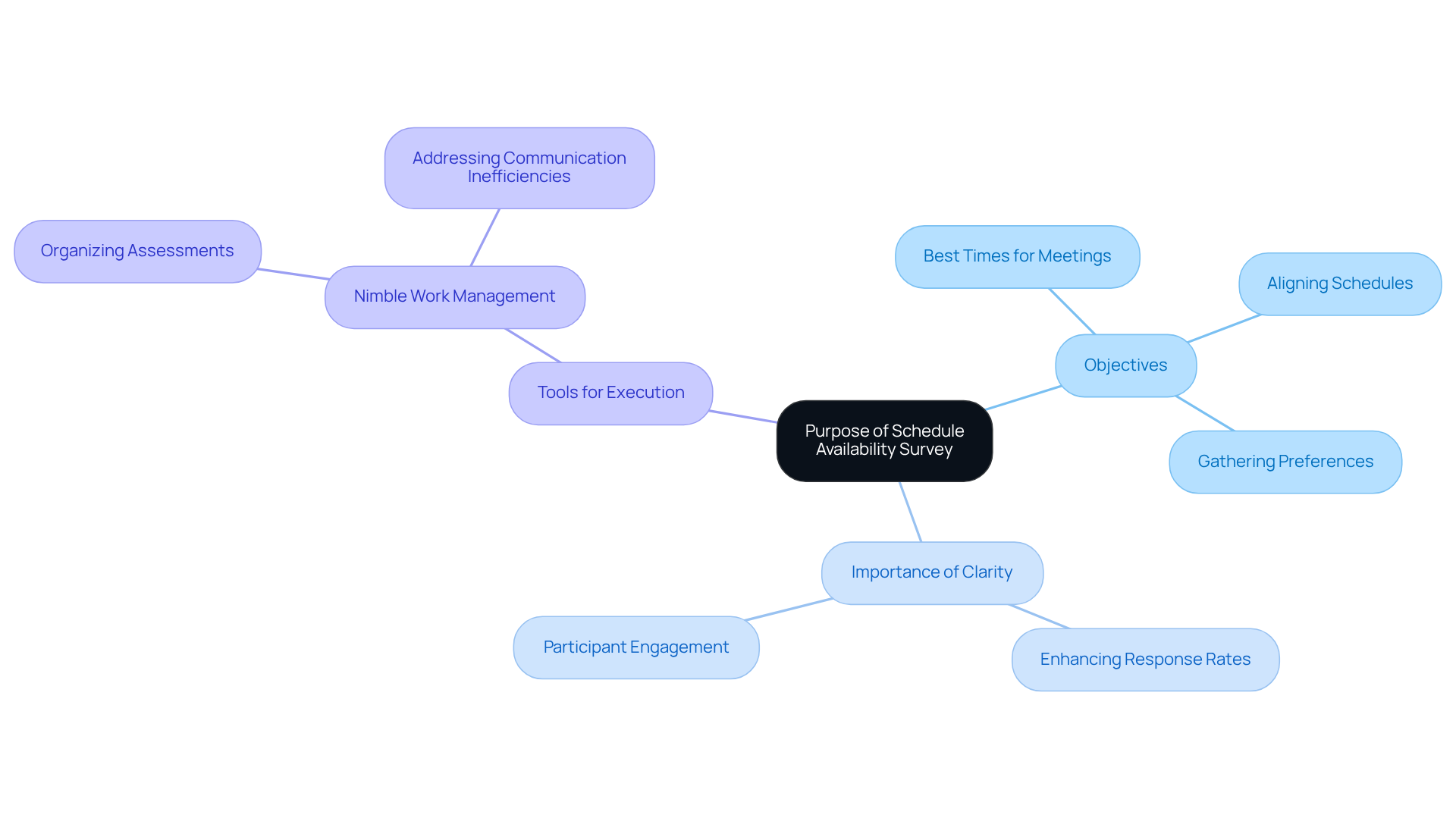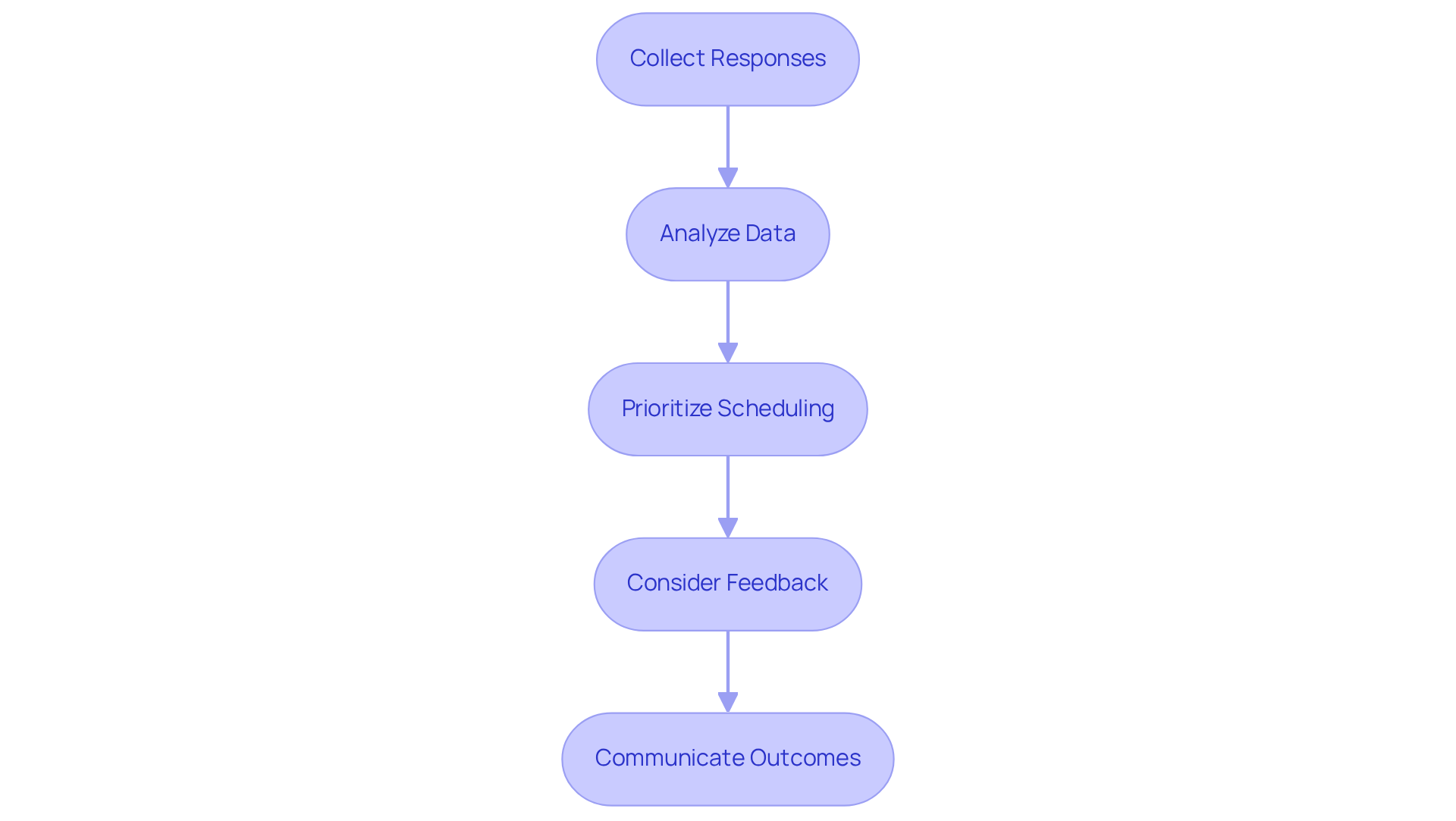5 Steps to Conduct a Schedule Availability Survey Effectively

Introduction
Crafting an effective schedule availability survey is not merely a formality; it’s a strategic endeavor that can significantly enhance team collaboration and project efficiency. Organizations often face communication inefficiencies that hinder productivity. By clearly defining the survey’s purpose and identifying the right audience, they can gather valuable insights that lead to optimal scheduling decisions.
However, what happens when the survey results reveal conflicting preferences or unexpected trends? This is where the true value of the survey lies. By employing best practices in question design, organizations can transform data into actionable scheduling strategies. Imagine the potential of aligning team availability with project timelines, ultimately driving efficiency and collaboration.
In this article, we will delve into the essential steps to conduct a schedule availability survey effectively. We’ll guide you through the process, showcasing how to turn insights into impactful scheduling solutions. Explore the journey of transforming data into strategies that not only meet team needs but also enhance overall operational efficiency.
Define the Purpose of Your Schedule Availability Survey
To begin, it’s essential to clearly articulate the primary objective of your schedule availability survey. Are you looking to pinpoint the best times for team meetings, align project schedules, or gather employee preferences using a schedule availability survey for working hours? Defining this objective will help you formulate relevant questions and identify the right audience for your research. For example, if your aim is to organize weekly team meetings, your inquiries should center on the preferred days and times for the majority of team members. Documenting this purpose in a concise statement keeps your research focused and aligned with your goals.
As Benjamin Franklin wisely stated, “By failing to prepare, you are preparing to fail,” underscoring the critical importance of preparation in achieving effective outcomes. Similarly, Dwight D. Eisenhower noted, “Plans are nothing, but planning is everything,” reinforcing the necessity of having a clear plan. Well-defined objectives not only streamline the process of the schedule availability survey but also significantly enhance response rates; participants are more likely to engage when they understand the purpose. This clarity cultivates a sense of purpose, making it easier for respondents to provide meaningful input.
Employing tools such as Nimble Work Management can further assist in organizing and executing your scheduling assessments efficiently. By leveraging such solutions, you can address communication inefficiencies head-on, ensuring that your team operates at peak efficiency. Don’t underestimate the power of a well-structured approach – explore how these tools can transform your scheduling processes today.

Identify Your Target Audience
Identifying the right participants for your schedule availability survey is not just important; it’s crucial. This group may include team members, contributors, or clients, depending on your specific scheduling needs. Consider their roles, availability, and the significance of their input in shaping the scheduling process. For instance, when arranging a project kickoff meeting, involving all key participants in the questionnaire is essential to guarantee thorough feedback.
Segment potential participants based on their relevance to the scheduling objectives. Effective audience selection can significantly enhance the survey’s effectiveness. Involving the appropriate participants not only improves the quality of the data gathered but also fosters a sense of ownership and teamwork-both vital for successful project outcomes. Companies that prioritize engagement with their stakeholders are 30% more likely to succeed with new initiatives. Moreover, projects with effective engagement plans succeed 83% of the time, compared to only 32% for those lacking them. This stark contrast underscores the importance of thoughtful audience selection in this process.
Furthermore, effective stakeholder involvement correlates with enhanced long-term financial performance. This further highlights the need for careful consideration of who is included in the assessment. By conducting a schedule availability survey to ensure that the right voices are heard, you not only gather valuable insights but also pave the way for a more collaborative and successful project environment.

Craft Effective Survey Questions
When designing survey items, it’s crucial to prioritize clarity and specificity. Ineffective communication can lead to misunderstandings and incomplete data. By employing a mix of closed-ended items – like multiple choice or rating scales – alongside open-ended prompts, you can capture both quantitative and qualitative insights effectively. For instance, consider asking, ‘Which of the following days works best for you for a meeting?’ This can be complemented by an open-ended prompt such as, ‘Please specify any additional preferences or constraints you have.’
This structure not only facilitates straightforward responses but also allows respondents to express unique considerations that may not be covered by predefined options. Formulating inquiries impartially is essential; it encourages sincere and reflective responses. Current best practices indicate that alternating between types of inquiries can sustain engagement and reduce respondent fatigue, ultimately leading to more thorough data collection.
Furthermore, it’s advisable to limit open-ended inquiries to 15-20% of the total to ensure higher completion rates. Remember, the aim of the assessment should dictate the choice of question types, ensuring that the design aligns with the intended outcomes. By following these guidelines, you can enhance the effectiveness of your surveys and gather more meaningful data.

Distribute Your Survey to the Target Audience
Once your questionnaire is ready, it’s crucial to select the most effective distribution method to reach your target audience. Consider options like:
- Social media
- Internal communication platforms such as Slack or Microsoft Teams
By customizing your outreach, you clarify the objective of the questionnaire and demonstrate how their feedback will be utilized. For instance, sending an email with a brief overview of the survey’s goals and a direct link to participate can significantly enhance engagement.
Setting a deadline for responses is another effective strategy to encourage timely participation. Recent trends indicate that emails dispatched from verified addresses during optimal periods – like mid-week – can dramatically improve response rates. Additionally, leveraging a built-in email distribution service allows you to track engagement over time, enabling a thorough assessment of your outreach’s impact.
By diversifying your distribution methods, you broaden your reach and tap into various audience segments. This approach maximizes participation and gathers valuable insights, ultimately addressing the operational challenges of communication inefficiencies. Embrace these strategies to enhance your questionnaire’s effectiveness and drive meaningful feedback.

Analyze Responses and Optimize Scheduling
After collecting responses, it’s essential to analyze the data to pinpoint common preferences and trends. By utilizing tools such as spreadsheets or analysis software, you can visualize the data effectively and highlight key findings. For instance, if a significant number of respondents prefer meetings on Wednesdays at 2 PM, prioritize that time slot for scheduling. Furthermore, take into account any open-ended feedback to address specific concerns or suggestions that may arise. Finally, communicate the survey outcomes to participants, expressing gratitude for their input and informing them of the scheduled times based on their preferences.

Conclusion
Conducting a schedule availability survey is not just a task; it’s a strategic endeavor that demands thoughtful preparation and execution. A well-planned survey does more than gather insights; it fosters collaboration and engagement among participants. By defining clear objectives, selecting the right audience, crafting effective questions, distributing the survey wisely, and analyzing the results, organizations can significantly optimize their scheduling processes and enhance overall productivity.
Key steps are essential to ensure the effectiveness of a schedule availability survey:
- Defining the survey’s purpose establishes a focused direction.
- Identifying the target audience guarantees that the right voices contribute valuable feedback.
- Crafting clear and specific survey questions facilitates meaningful responses.
- Employing diverse distribution methods maximizes participation.
- Analyzing the collected data allows for informed decision-making and scheduling that aligns with participants’ preferences.
Embracing these best practices streamlines scheduling efforts and cultivates a culture of inclusivity and responsiveness within teams. Organizations are strongly encouraged to implement these strategies to improve their scheduling processes, engage stakeholders effectively, and drive success in their initiatives. Prioritize clarity of purpose, the importance of audience selection, and the power of data analysis to transform scheduling challenges into opportunities for collaboration and efficiency.
Frequently Asked Questions
What is the purpose of a schedule availability survey?
The purpose of a schedule availability survey is to identify the best times for team meetings, align project schedules, or gather employee preferences regarding working hours. Clearly defining this objective helps formulate relevant questions and target the right audience for the survey.
Why is it important to define the objectives of the survey?
Defining the objectives of the survey streamlines the process, enhances response rates, and helps participants understand the purpose, leading to more meaningful input. A clear purpose keeps the research focused and aligned with goals.
How can tools like Nimble Work Management assist in scheduling assessments?
Tools like Nimble Work Management can help organize and execute scheduling assessments efficiently, address communication inefficiencies, and ensure that the team operates at peak efficiency.
Who should be included in the target audience for the survey?
The target audience for the survey may include team members, contributors, or clients, depending on specific scheduling needs. It’s important to consider their roles, availability, and the significance of their input in shaping the scheduling process.
How does effective audience selection impact the survey’s effectiveness?
Effective audience selection enhances the quality of the data gathered and fosters a sense of ownership and teamwork, which are vital for successful project outcomes. Engaging the right participants increases the likelihood of success for new initiatives.
What are the benefits of involving stakeholders in the scheduling process?
Involving stakeholders can lead to a higher success rate for projects, with companies prioritizing engagement being 30% more likely to succeed with new initiatives. Projects with effective engagement plans succeed 83% of the time compared to only 32% for those lacking such plans.
What is the overall significance of conducting a schedule availability survey?
Conducting a schedule availability survey ensures that the right voices are heard, gathers valuable insights, and paves the way for a more collaborative and successful project environment.
